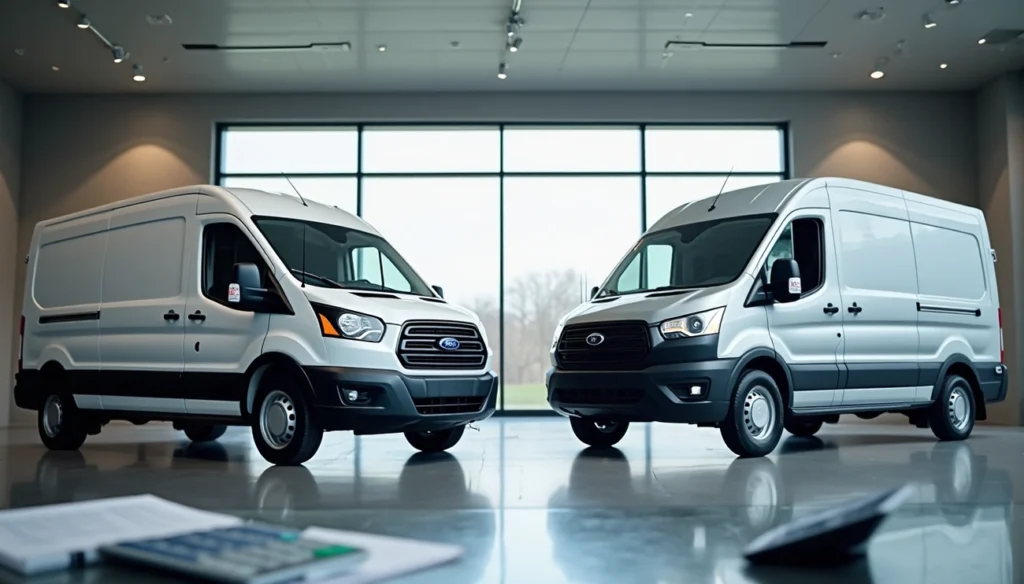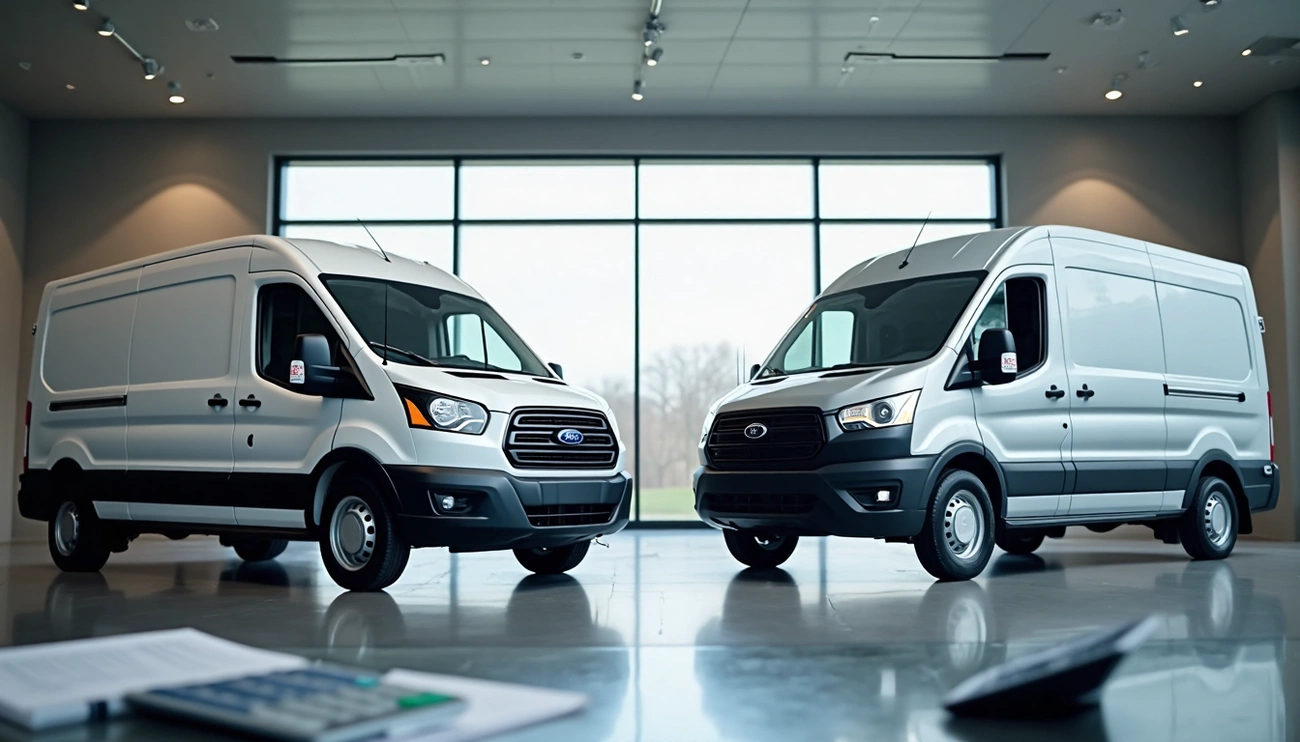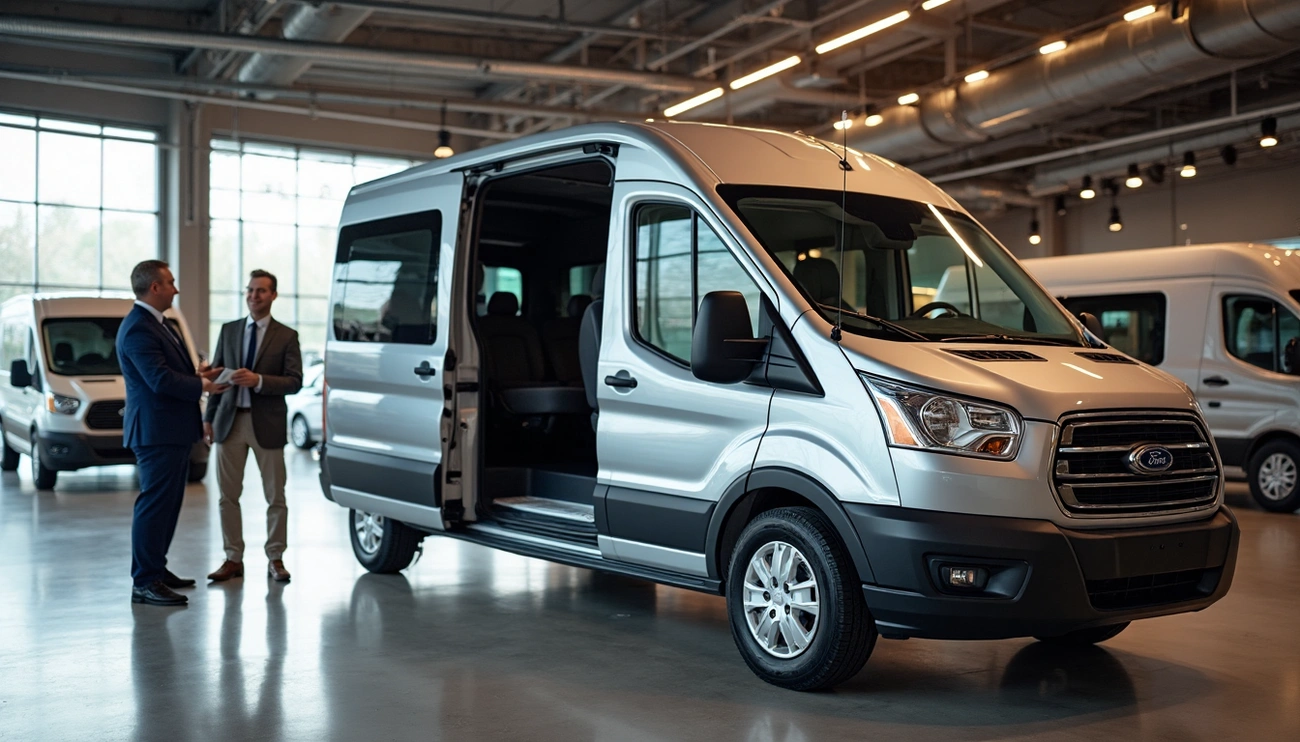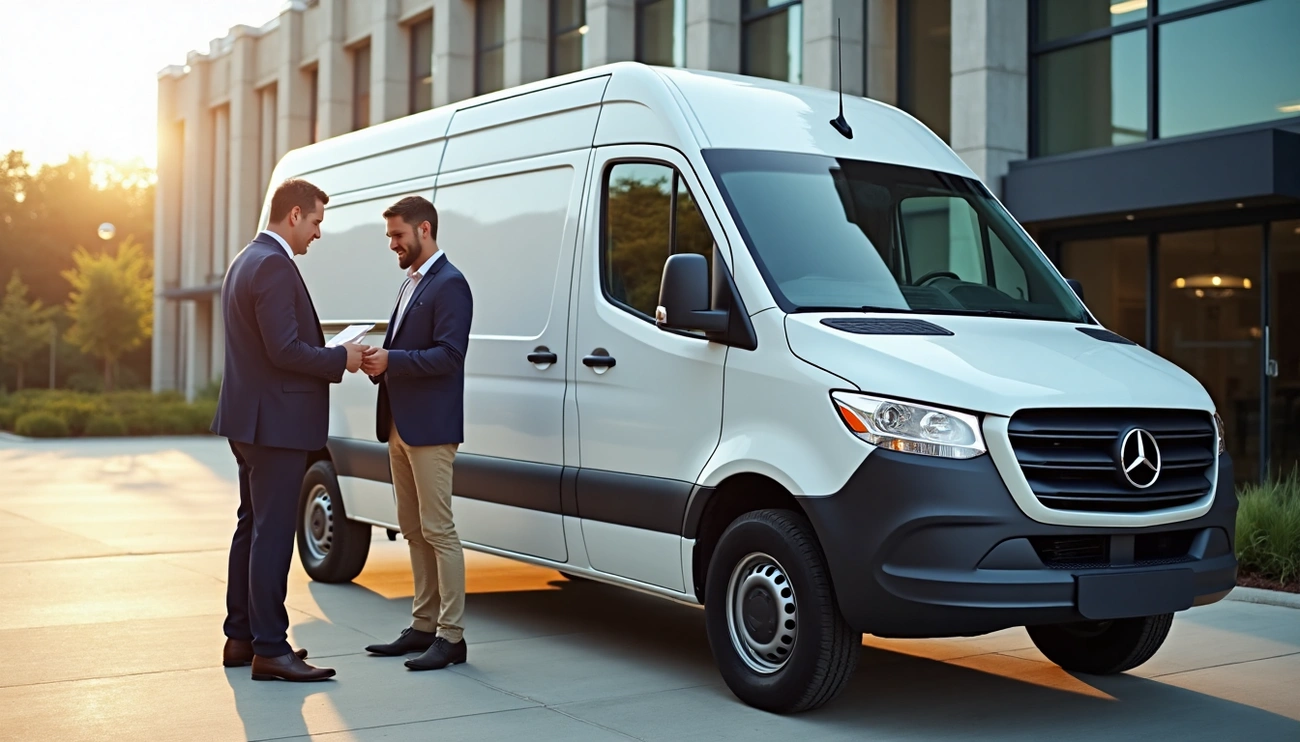Van Finance Lease vs. Hire Purchase
Van Finance lease payments can save you up to 40% off your vehicle costs.
Pretty impressive, right? Van Finance lease works brilliantly for vans—letting you spread costs instead of paying everything upfront. Buy a van outright and you’ll hand over the full amount immediately. Choose finance lease and you can spread that cost over 24 to 60 months. Source

Here’s where it gets interesting for business owners.
Finance lease and hire purchase might sound similar, but they work quite differently. With finance lease, you’ll pay a fixed monthly fee with various benefits included—just like contract hire. The difference? You only need 3x monthly rental payment upfront. See self employed van finance
There’s a catch though. At the end of your contract, you’ll face a large balloon payment based on your vehicle’s estimated value. See business van finance
Both options have their sweet spots depending on your business needs.
We’ll walk you through payment structures, tax considerations, and flexibility factors. Whether you’re exploring van finance in North Cheam, Surrey, or anywhere across the UK, you’ll discover which option fits your business goals perfectly. See electric van finance
Ready to find your ideal van finance solution?
Understanding Van Finance Lease and Hire Purchase
Let’s break down how these two popular van finance lease options actually work.
What is a van finance lease?
Think of van finance lease as a long-term rental agreement. Your business pays to use a vehicle over an agreed period without actually owning it. The finance company maintains legal ownership of the van throughout. Most agreements run between 24 and 60 months, giving businesses flexibility without the burden of full upfront payment. See used van finance
Finance leases come in two main forms.
Full pay out agreement spreads the total cost evenly across your term. Balloon payment option features lower monthly payments plus a larger final payment based on the van’s estimated residual value at the end.
Finance leases appear on your company’s balance sheet as both an asset and a corresponding liability. Monthly payments include VAT rather than requiring it all upfront, making this option particularly attractive for managing cash flow.
At the end of a finance lease, you have three options:
- Sell the vehicle on behalf of the finance company and receive a percentage of the proceeds (usually around 95%)
- Enter a secondary rental period (often called a “peppercorn rental”)
- Allow the finance company to sell the vehicle and refund you a portion of the sale
What is hire purchase (HP) for vans?
Van Hire purchase offers a straightforward path to van ownership. Unlike finance lease, HP allows you to eventually own the vehicle once all payments are completed. You’ll typically make an initial deposit (usually 10-20% of the value), followed by fixed monthly installments over an agreed period, generally between 1-5 years.
Here’s the key difference: with HP, you’ll pay all the VAT upfront rather than spreading it across the term. While this creates a higher initial outlay, VAT-registered businesses can typically reclaim this amount in their next VAT return, potentially boosting early cash flow.
Monthly payments under hire purchase are VAT-free since you’ve already paid this at the beginning. Once you’ve made all payments including a nominal “option to purchase” fee, the van becomes yours completely.
Key differences in ownership and structure
The main distinction between these financing methods centers on ownership. With finance lease, the leasing company always retains ownership of the van. With hire purchase, you own the vehicle after completing all payments.
Several other crucial differences exist:
First payment structure varies significantly between options. Finance lease typically requires around £1500 + VAT initially, while hire purchase demands the van’s VAT plus about 10% of the purchase price upfront.
Monthly payments differ too. With finance lease, you’ll pay the agreed amount plus the vehicle’s VAT spread across payments. For hire purchase, monthly payments exclude VAT since you’ve already paid this upfront.
End-of-agreement options also diverge considerably. Finance lease offers flexibility through secondary rentals or selling the vehicle, whereas hire purchase culminates in ownership after paying the final “option to purchase” fee.
Both options provide viable paths to acquiring a commercial vehicle without full upfront payment, yet with distinctly different structures and outcomes.
How Each Option Works in Practice
Both financing options work differently in day-to-day business operations. Here’s what you need to know about payment structures and end-of-term responsibilities.
Monthly payments and balloon payments
Payment structure creates the biggest difference between van finance options.
Finance lease offers two distinct arrangements:
Full pay-out agreement spreads costs evenly across your term. No final large payment means straightforward budgeting throughout the lease period.
Balloon payment structure lowers monthly obligations by deferring a substantial portion until the end. Consider a commercial van worth £36,256—you might pay an initial rental of £2,979.80 followed by 35 monthly payments of £369, culminating in a final balloon payment of £10,325.
Hire purchase typically requires a deposit between 10-20% of the vehicle’s value, followed by fixed monthly installments covering the remainder plus interest. Traditional hire purchase divides the total cost across higher monthly payments without a balloon payment.
Some lenders offer balloon hire purchase—combining elements of both systems with a deferred payment at the end. This hybrid approach results in lower monthly payments than standard hire purchase while still leading to ownership.
End-of-term responsibilities
Your agreement’s conclusion reveals where these options truly diverge.
Finance lease presents several choices:
- Sell the vehicle on behalf of the finance company to a third party
- Enter a secondary rental period (often called “peppercorn rental”)
- Allow the finance company to sell the vehicle
Sell the vehicle yourself and you’ll typically receive around 95-98% of the proceeds, with the finance company retaining a small percentage. Sale value exceeding any balloon payment? You keep the difference (minus the finance company’s fee). Sale price falling short of the balloon amount? You must cover the difference.
Secondary rental allows continued use by paying an annual fee, usually equivalent to one monthly payment. This arrangement can continue for up to five years.
Hire purchase keeps things simple—once you’ve made all payments (including any balloon payment for balloon hire purchase), you own the vehicle outright. No obligation to sell or return it, giving you complete freedom to keep, modify, or sell as you wish.
Van finance lease explained with examples
Real-world scenarios show how these options work in practice:
A delivery business needing five vans worth £200,000 total might choose hire purchase with a £40,000 deposit followed by monthly payments of £3,200 over five years. At term end, they own the vehicles outright, can claim capital allowances, and plan to use the vans for eight+ years.
A company requiring a Vivaro Panel Van Prime might select a finance lease with an initial rental of £2,979.80, followed by 35 monthly payments of £369, concluding with a £10,325 balloon payment. After the term, they could sell the van to settle the balloon payment, potentially keeping any excess value.
Finance lease works particularly well for businesses facing fluctuating mileage requirements or anticipating vehicle wear and tear beyond normal use. There are no strict mileage penalties as with contract hire, though excessive mileage will reduce the vehicle’s resale value.
Businesses requiring frequent vehicle upgrades benefit from finance lease flexibility through options to refinance the balloon payment or trade in for a newer model. Hire purchase better suits companies planning long-term vehicle retention or those wanting to build tangible assets on their balance sheet.
Financial Implications and Tax Considerations
Tax treatment can make or break your van finance decision. Here’s what you need to know about the money side of things.
VAT treatment and reclaim options
VAT handling differs dramatically between your options.
With hire purchase, you’ll pay VAT upfront on the full vehicle price. VAT-registered businesses can reclaim this amount against their next VAT return—giving you an immediate cash flow boost.
Finance lease spreads VAT across monthly payments instead. Much better for cash flow concerns. Plus, you can reclaim 50% of the VAT on monthly payments, or 100% if the vehicle is used exclusively for business.
Here’s the kicker: hire purchase vans qualify for capital allowances once ownership transfers to you. Finance lease payments count as tax-deductible operating expenses.
Equity potential and depreciation risks
Depreciation risk sits squarely on your shoulders with hire purchase. The vehicle appears as an asset on your balance sheet, letting you write down its value using standard allowances.
Finance lease protects you from unpredictable residual values. This protection proves especially valuable with electric vans, where future values remain uncertain due to rapidly changing technology. Perfect for businesses that update fleets regularly.
Impact on business cash flow
Finance leasing demands lower initial outlay compared to hire purchase. Your working capital stays free for other business needs instead of being tied up in vehicle assets.
Finance lease payments appear as operating expenses, potentially keeping the lease off your balance sheet and improving financial ratios. Lenders view this favourably when you’re seeking additional financing.
Contract hire continues gaining popularity because it provides low initial outlay, fixed costs, depreciation protection, plus VAT reclaim benefits. Businesses increasingly choose this option to avoid residual value uncertainties, especially when transitioning to electric vehicles.
Remember: complex tax considerations exist beyond these basics. Annual reviews of your fleet funding strategy are recommended, especially as legislation changes regarding benefit-in-kind tax rates and capital allowance thresholds.
Flexibility, Risk, and Control Van Finance lease
Van financing isn’t just about monthly payments—it’s about how much control you’ll have over your business wheels.
Early termination and refinancing options
Need to end your agreement early? Both options allow this, but the costs differ significantly.
Finance lease agreements let you request a settlement figure if you need out early. Fair warning though—you’ll often find yourself “upside down” where the settlement exceeds what your van’s actually worth. Hire purchase early termination can hit you with up to 50% of your remaining monthly payments.
Refinancing tells a different story. Finance lease offers something called “peppercorn rental”—you can keep using your van for up to three years after your original lease ends for a nominal fee. Hire purchase lets you refinance any balloon payment (minimum £1,500) into another agreement if you’ve chosen that route.
Mileage and damage responsibilities
Here’s where things get practical.
Finance lease gives you flexibility with mileage compared to contract hire. Your mileage gets pooled across the entire term—so a 3-year contract with 10,000 miles annually gives you 30,000 miles to use however suits your business.
Damage works differently too. With finance lease, any damage simply reduces your van’s resale value. No excess damage charges like contract hire—just less money back when you sell. Hire purchase vans become your property, so any damage is yours to handle.
Customisation and van modifications
Want to make your van truly yours?
Hire purchase gives you complete modification freedom once you’ve finished payments. Finance lease allows modifications during your agreement, though this might affect what you get back at resale.
Common modifications that work well include:
- Custom alloy wheels
- Dash cameras
- Ply-lining
- Privacy glass
- Roof racks
Some changes stay off-limits with finance leases—paint color changes, non-removable sign-writing, and modifications requiring drilling that damages bodywork.
Finance lease offers flexibility during your agreement. Hire purchase gives you complete control once that final payment clears.
Choosing the Right Option for Your Business
Your business circumstances determine which van finance option works best. Here’s what fits where.
When to choose van finance lease
Cash flow matters most? Finance lease is your friend.
You’ll only need 3 months’ rental payment upfront—perfect for businesses with limited starting capital. VAT-registered companies get significant benefits too, as payments count as ongoing expenses with up to 100% tax deductibility.
Finance lease works brilliantly for vans that take a beating during their working life. No condition penalties at contract end. Worried about depreciation risks? Finance lease protects you since the leasing company keeps ownership.
When hire purchase makes more sense
Want to own your van? Hire purchase delivers exactly that.
This straightforward path excels for high-mileage businesses—HP agreements don’t restrict your mileage. Planning to keep vehicles long-term (over 5 years)? HP typically costs less overall. Plus, businesses wanting vans as balance sheet assets often prefer HP.
Van finance comparison: key decision factors
Your choice depends on these factors:
- Cash availability: Finance lease needs less upfront capital
- Usage timeline: Short-term needs (2-4 years) suit leasing; longer needs suit HP
- Mileage expectations: High mileage drivers benefit from HP’s unrestricted usage
- Tax position: Stable businesses might maximize tax benefits through HP’s capital allowances
- Asset depreciation: Equipment losing value quickly (like technology-heavy vans) suits leasing
Van finance lease deals in North Cheam and Surrey
Local dealers in North Cheam and Surrey offer competitive finance lease packages with flexible terms. Many provide customizable agreements including contract hire options and maintenance packages suitable for local businesses.
Self-employed individuals in Surrey often find finance lease cheaper than buying outright while gaining significant tax advantages.
The Right Van Finance Choice for You
Your business needs determine whether finance lease or hire purchase works best.
Finance lease suits businesses wanting lower upfront costs and protection from depreciation risks. Monthly payments include VAT and count as tax-deductible expenses—perfect for cash flow management.
Hire purchase works brilliantly if ownership matters to you. Higher upfront costs, but you’ll own the van outright once payments finish. No mileage restrictions either.
Tax considerations matter too. Finance lease payments reduce your taxable profits, while hire purchase creates balance sheet assets with capital allowances.
Think about your planned usage period, anticipated mileage, and cash position. Short-term needs often favor leasing. Long-term plans typically suit hire purchase better.
Small businesses with tight cash flow benefit from finance lease flexibility. Established companies might prefer hire purchase’s asset-building advantages.
The best choice matches your immediate needs and long-term business strategy. Both options let you get the van you need without paying everything upfront.
Ready to choose your van finance option? Understanding these differences helps you make the right decision for your business.
Key Takeaways Van Finance lease
Understanding the differences between van finance lease and hire purchase can save your business thousands while optimizing cash flow and tax benefits.
• Finance lease requires only 3 months’ rental upfront versus hire purchase’s 10-20% deposit plus full VAT payment • With finance lease, you’re protected from depreciation risks since the leasing company retains ownership throughout • Hire purchase leads to full ownership after final payment, making it ideal for high-mileage or long-term use • Finance lease payments are 100% tax-deductible business expenses, while hire purchase creates balance sheet assets • Choose finance lease for better cash flow and flexibility; choose hire purchase for ownership and unrestricted usage • VAT treatment differs significantly: finance lease spreads VAT across payments, hire purchase requires upfront VAT payment
The right choice depends on your cash position, planned usage duration, mileage expectations, and whether you prioritize ownership or operational flexibility. Both options offer viable paths to van acquisition without full upfront payment.




